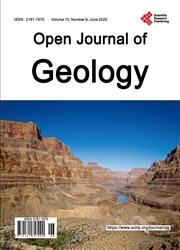Geochemical and Behavioral Modeling of Phosphorus and Sulfur as Deleterious Elements of Iron Ore to Be Used in Geometallurgical Studies, Sheytoor Iron Ore, Iran
引用次数: 2
Abstract
Sheytoor Iron Ore deposit is located in Yazd province of Iran (Bafq). The most abundant ore is magnetite, which can be seen in the form of mass and granular tissue in various forms of self-shaped, semi-self-shaped and amorphous. The main purpose of this study is to identify the geochemical relationship of phosphorus and sulfur elements and also three-dimensional modeling of mineralization of these elements in iron ore. In order to achieve the research goal, methods such as k-mean clustering technique, concentration-volume fractal as well as block modeling with kriging estimator and Inverse Distance Weighting (IDW) interpolator were used. The model of geochemical behavior of phosphorus and sulfur elements compared to iron is of great impor-tance because these two elements are known as deleterious elements in mineral processing and steelmaking processes, which are the post-mining stages. Existence of geochemical model and identification of elements’ behavior towards each other play a key role in optimizing mining operations in order to achieve geometallurgical goals. The results of this study are the three-dimen-sional model of mineralization of iron, phosphorus and sulfur elements, separation of phosphorus and sulfur mineralization communities and also pre-senting the model of enrichment community of these two elements. All the results are in line with geometallurgical studies and can optimize the next steps by optimizing the mining process.铁矿中磷和硫作为有害元素用于地学研究的地球化学和行为模拟,Sheytoor Iron Ore,伊朗
Sheytoor铁矿位于伊朗亚兹德省(Bafq)。矿石中最丰富的是磁铁矿,以块状和粒状组织形式存在,有自形、半自形和无定形等多种形式。本研究的主要目的是识别铁矿石中磷、硫元素的地球化学关系,并对这些元素的成矿作用进行三维建模。为了实现研究目标,采用了k-均值聚类技术、浓度-体积分形技术以及基于kriging估计和逆距离加权(IDW)插值的区块建模方法。磷和硫元素与铁元素相比的地球化学行为模型具有重要意义,因为这两种元素在矿物加工和炼钢过程中被称为有害元素,这是开采后的阶段。地球化学模型的建立和元素间相互作用的识别是优化采矿作业以实现地质冶金目标的关键。研究结果建立了铁、磷、硫元素成矿的三维模型,分离了磷、硫的成矿群落,并提出了铁、磷、硫的富集群落模型。研究结果与地矿学研究结果一致,可通过优化开采工艺对下一步进行优化。
本文章由计算机程序翻译,如有差异,请以英文原文为准。
求助全文
约1分钟内获得全文
求助全文

 求助内容:
求助内容: 应助结果提醒方式:
应助结果提醒方式:


